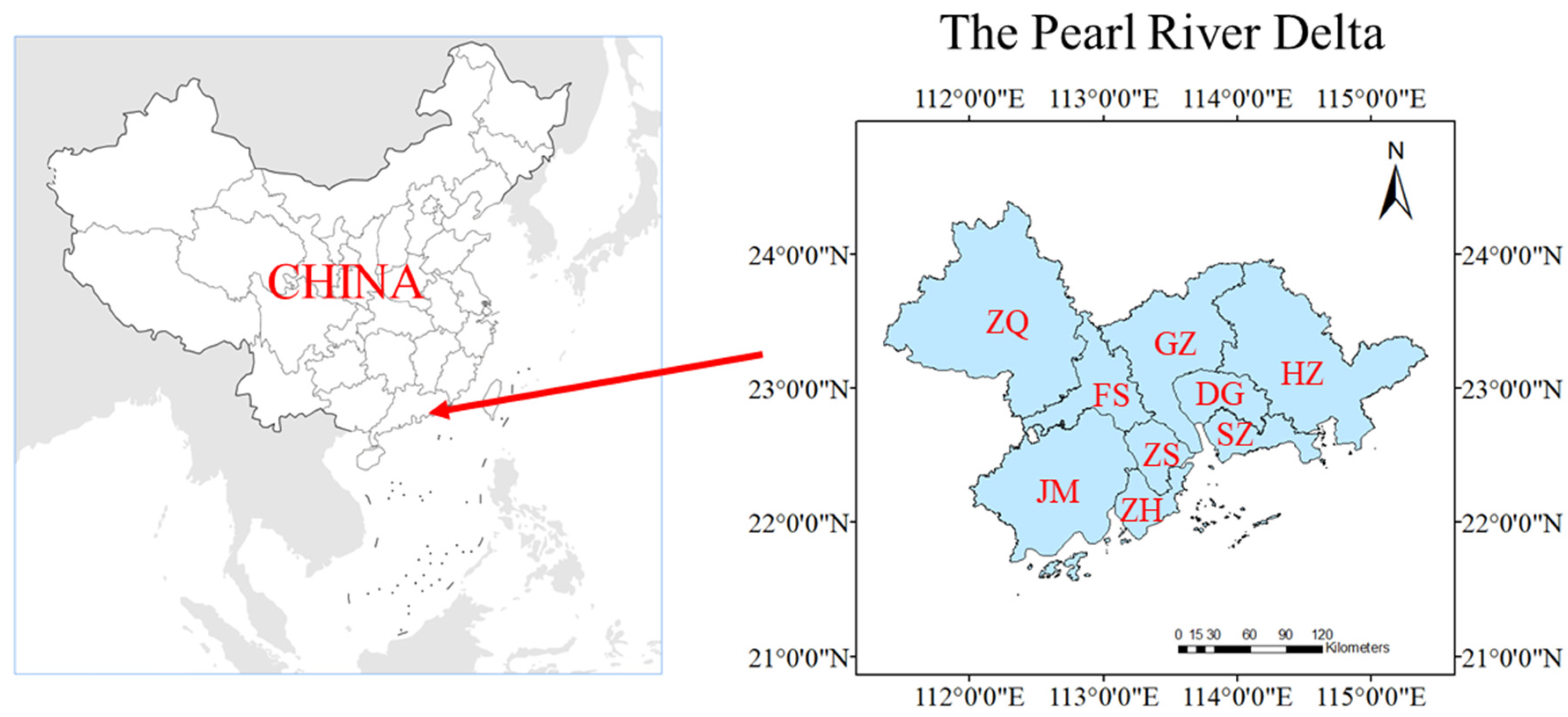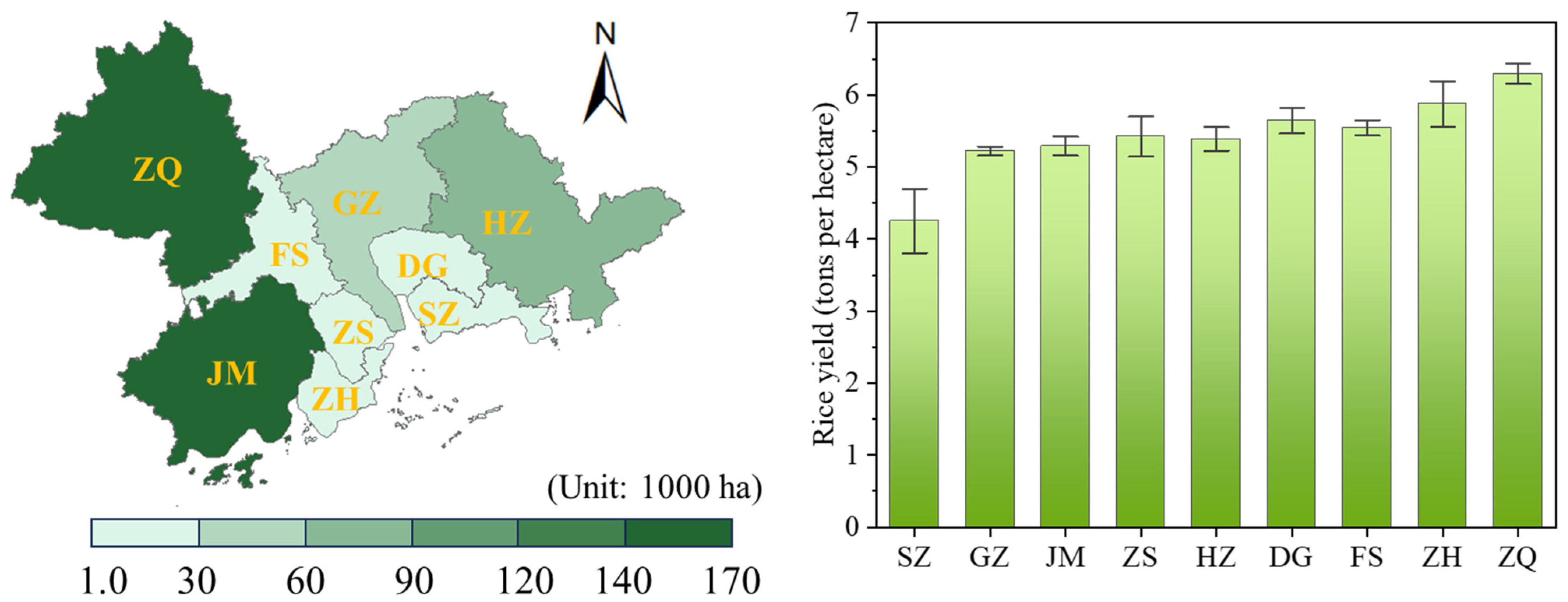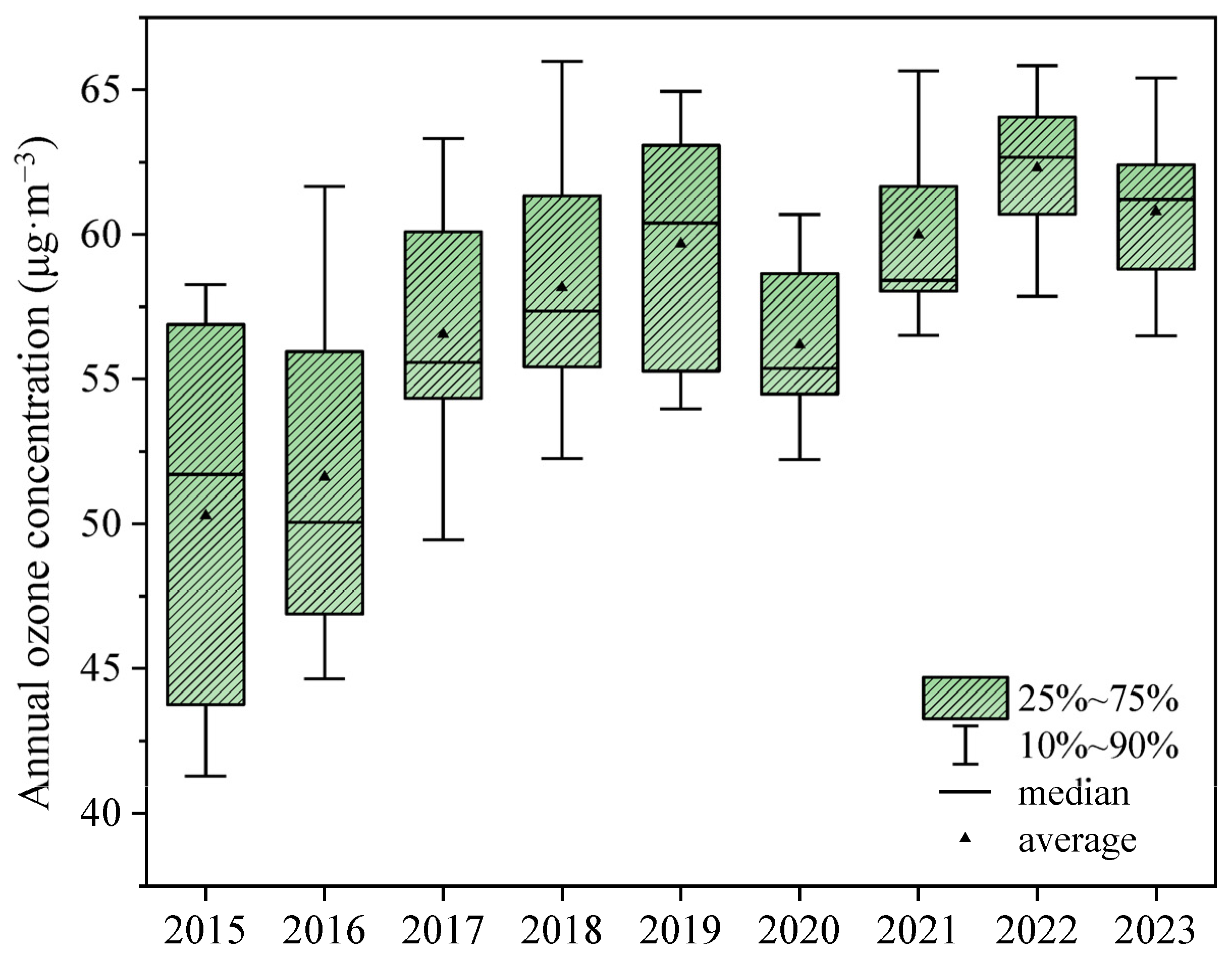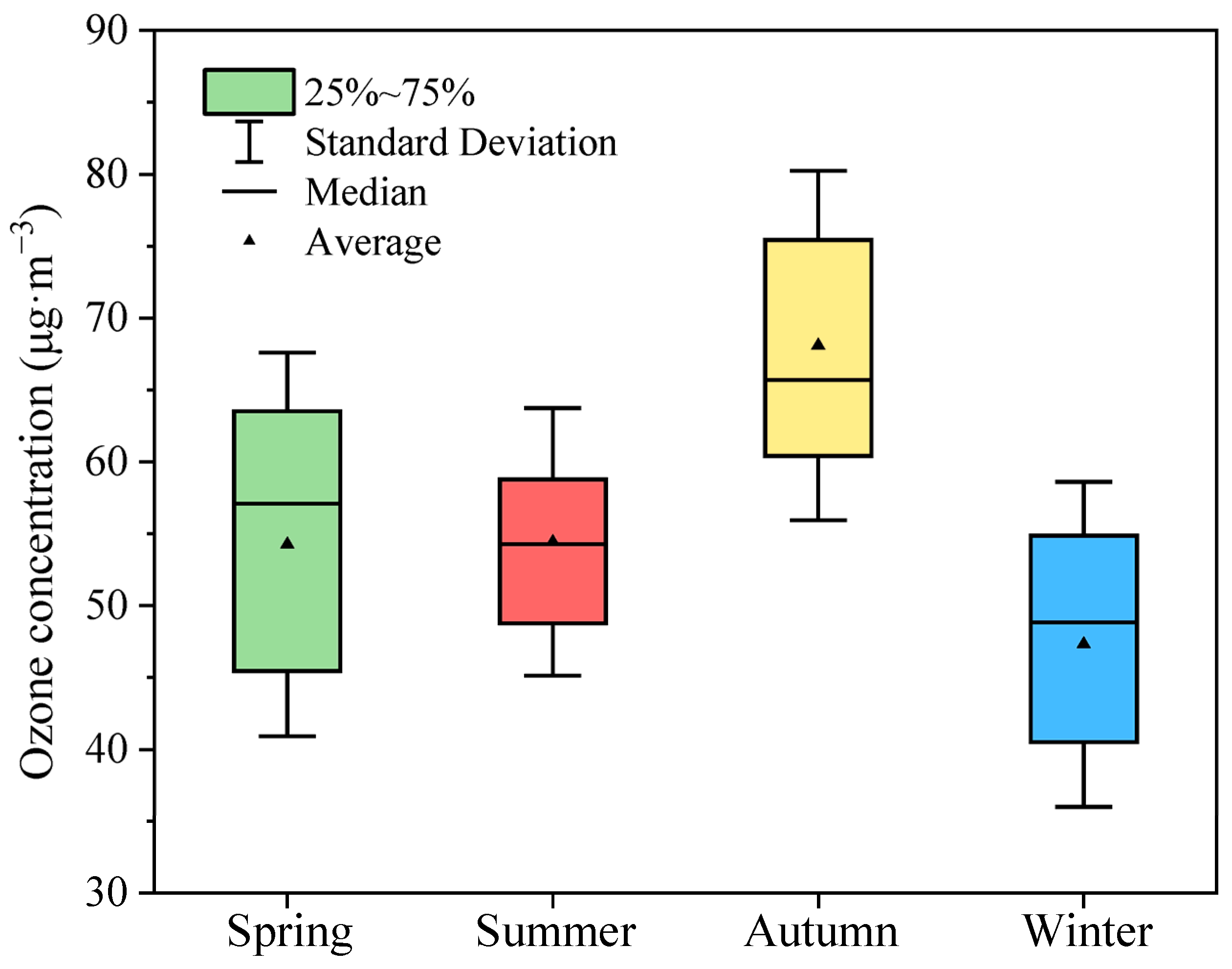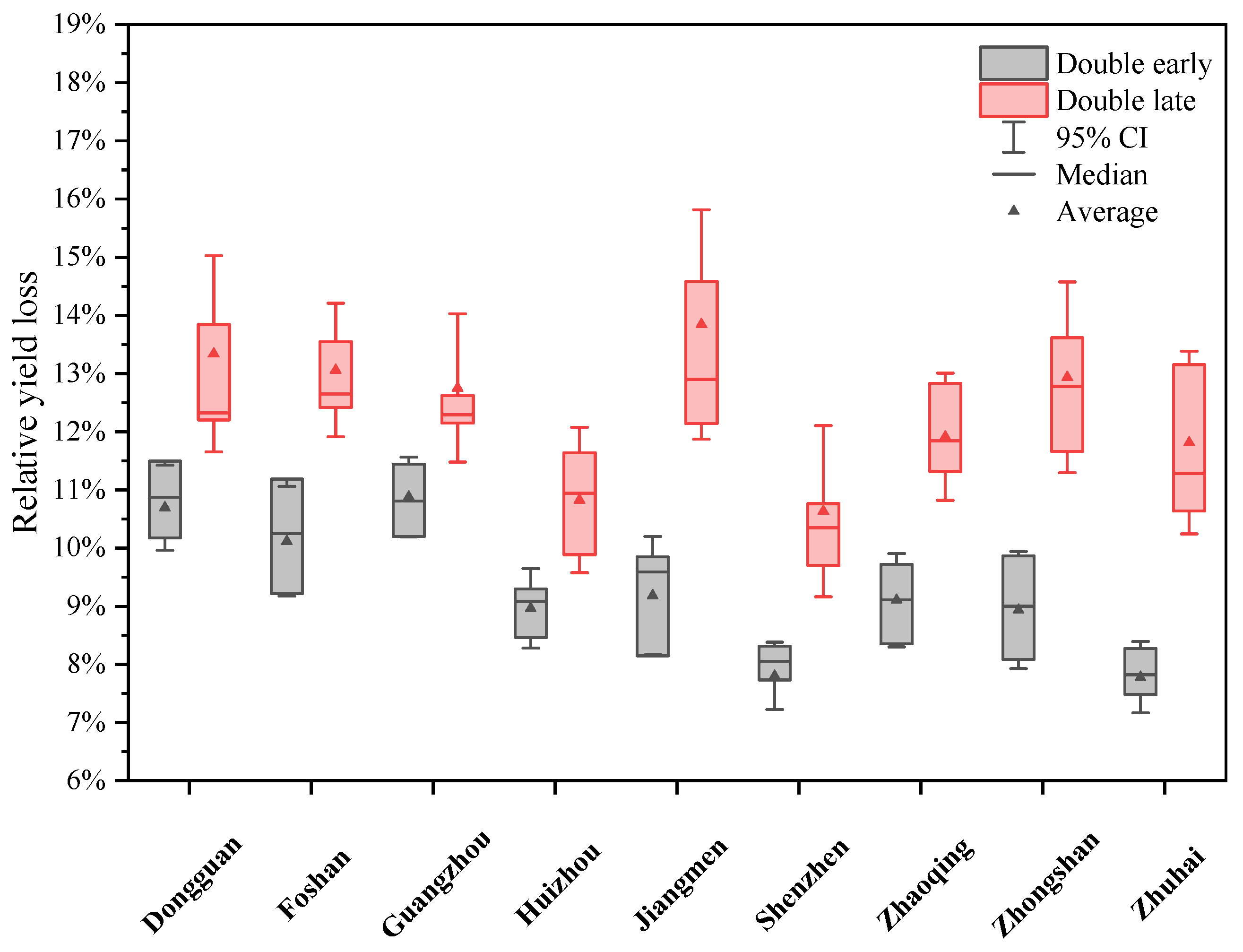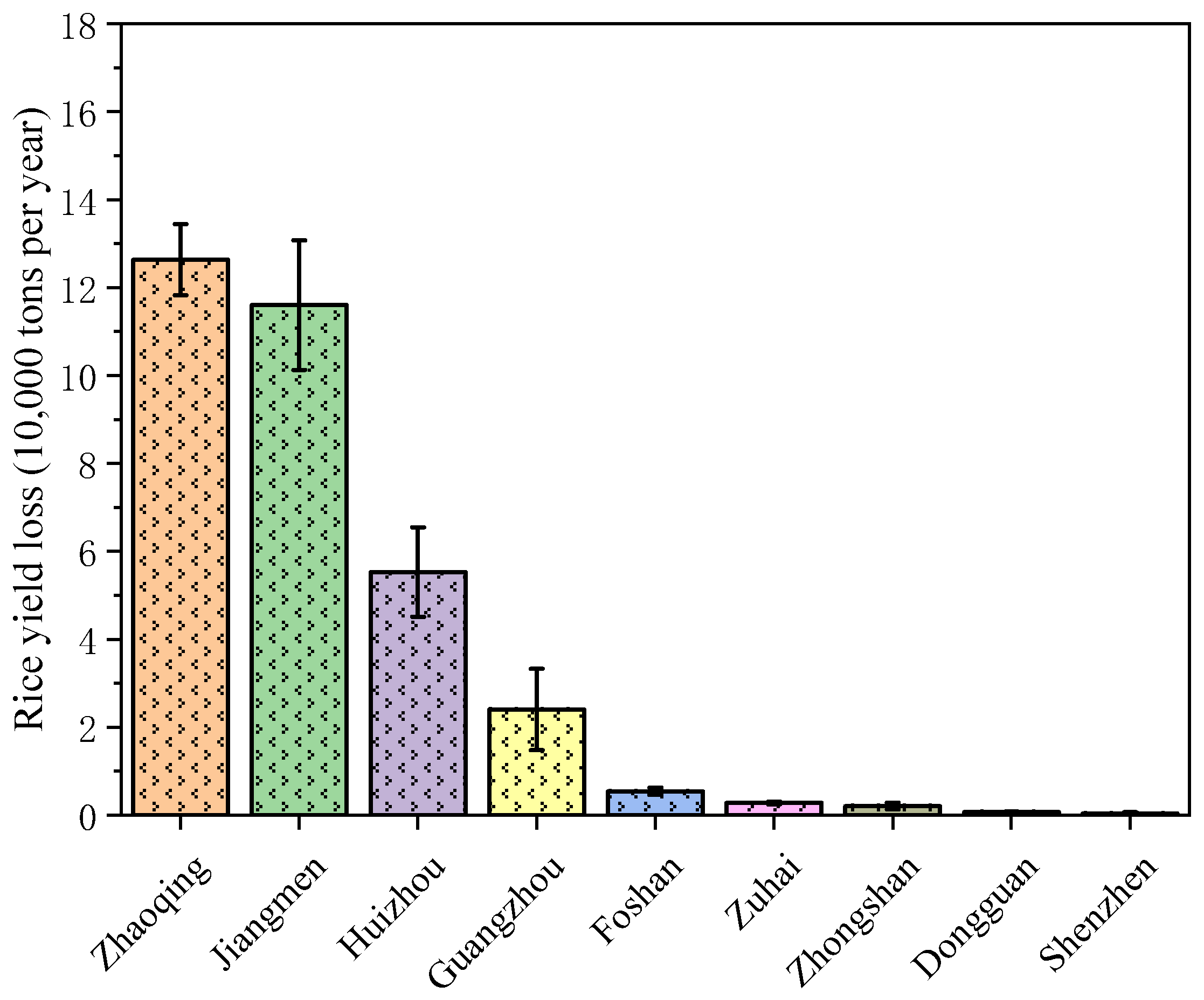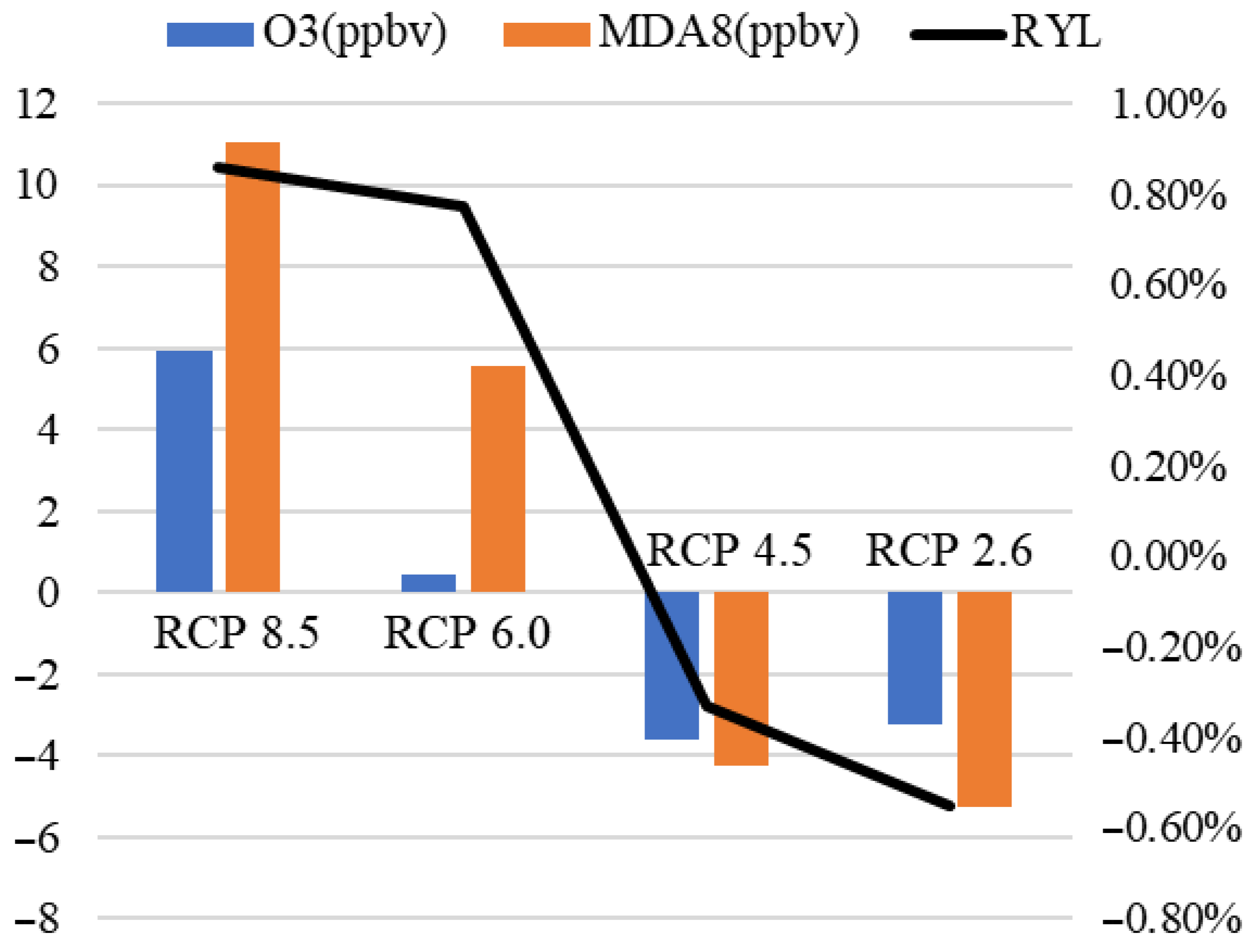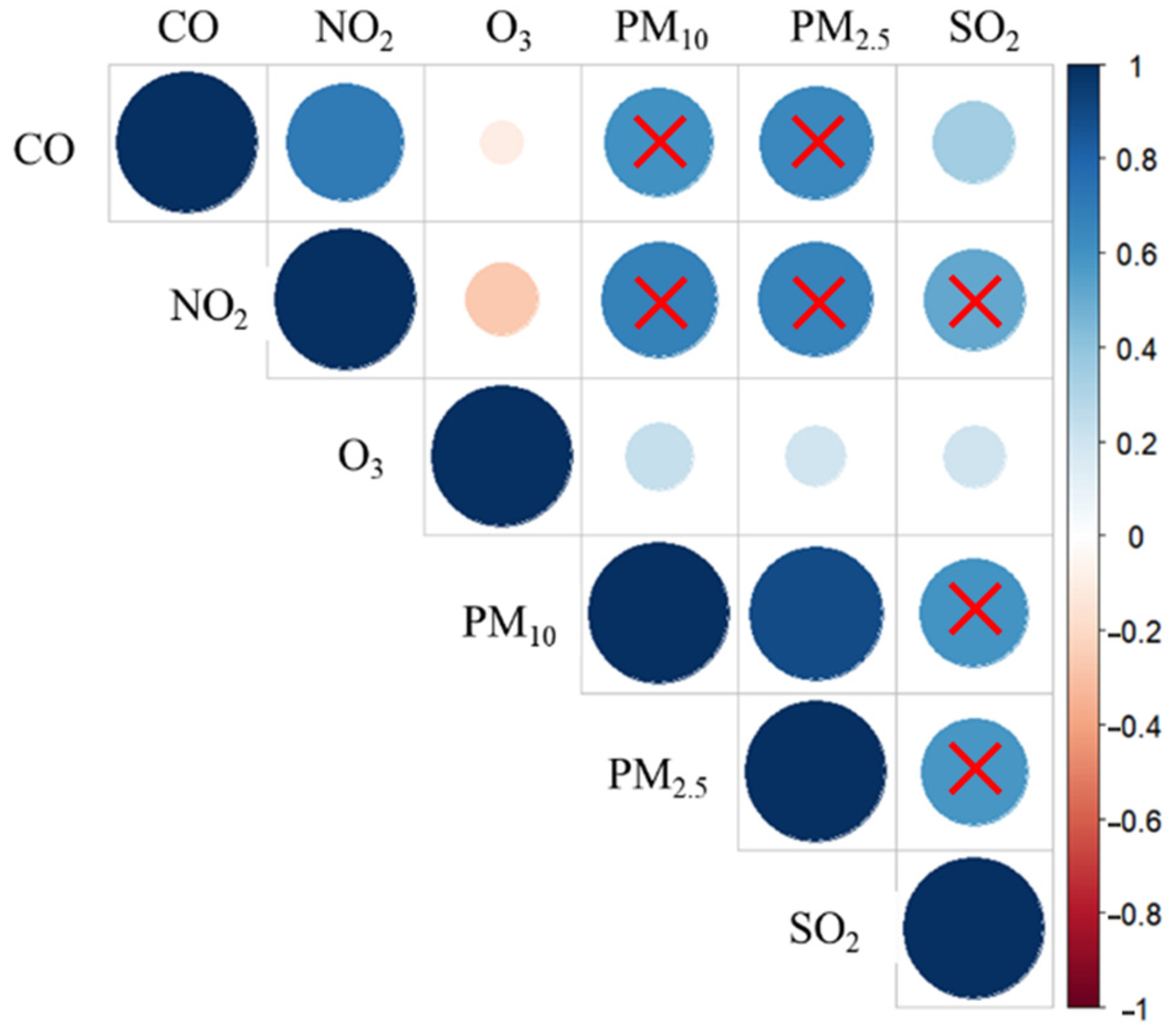1. Introduction
Rice constitutes a cornerstone of global food security, serving as the principal staple for nearly half of the world’s population [
1]. As one of the birthplaces of rice cultivation, China has a rich agricultural history spanning over 10,000 years [
2,
3,
4]. The rice production of China is primarily concentrated in the Central China, Southwest China, East China, South China, and Northeast China regions that benefit from unique geographical and climatic advantages. These areas have developed diverse cultivation patterns and rice varieties well adapted to local environments. However, rice cultivation in China faces significant environmental challenges, including water scarcity, extreme weather events, soil degradation, biodiversity loss, rising sea levels, and air pollution. Among these, air pollution, particularly near-surface ozone, poses a severe threat to rice yield, quality, and sustainable agricultural development [
5,
6,
7].
In recent decades, near-surface ozone concentrations have risen globally, particularly in regions undergoing rapid urbanization and industrialization. This trend has led to significant environmental challenges [
8,
9,
10,
11,
12]. Unlike primary pollutants, ozone is a secondary pollutant generated through photochemical reactions involving nitrogen oxides (NO
x) and volatile organic compounds (VOCs). As illustrated in
Figure 1, solar radiation dissociates nitrogen dioxide (NO
2) into nitric oxide (NO) and oxygen atoms (O), which subsequently combine with molecular oxygen (O
2) to produce ozone (O
3). VOCs interact with hydroxyl radicals (OH) to form peroxy radicals (RO
2), which convert NO back into NO
2, perpetuating the ozone production cycle [
13,
14,
15,
16,
17]. Major sources of these precursors include vehicular emissions, industrial processes, and biomass burning, alongside natural contributions from soil and vegetation. Both anthropogenic emissions and climate change contribute to the observed increase in surface ozone levels [
8,
18,
19].
Elevated near-surface ozone levels adversely affect human health and agricultural productivity [
20,
21,
22,
23]. Ozone enters leaf tissues via stomata, generating reactive oxygen species (ROS) that damage cellular structures, inhibit photosynthesis, and impair crop growth and development [
24,
25,
26,
27,
28]. Research shows that ozone stress significantly reduces critical rice growth metrics, such as tiller number, 1000-grain weight, and straw weight, with yield losses exceeding 20% in some cases. Additionally, high ozone exposure can increase the spikelet sterility rate by up to 19.26% [
29]. To quantify the impact of ozone on agriculture, researchers have utilized Open-Top Chambers (OTCs) and Free-Air CO
2 Enrichment (FACE) technologies [
30]. These methods, combined with the AOT40 index (Accumulated Ozone Exposure over a Threshold of 40 ppb during daylight hours in the rice-growing season), have enabled a deeper understanding of ozone’s cumulative effects on crops. For instance, rice yield losses can reach 58.3% at an ozone concentration of 138.3 ppb according to AOT40 calculations [
31].
Some studies have demonstrated that elevated ambient ozone concentrations can substantially reduce crop yields, especially for sensitive staples such as wheat, soybean, and rice [
31]. Ozone pollution posed substantial threats to China’s rice production during the 2013–2020 period, with an estimated annual yield reduction of 5.9–11.4 million tons [
32]. Detailed analyses revealed that double-cropping systems exhibited particularly severe impacts between 2015 and 2018, with yield losses reaching 3.9–6.8% for early-season rice and 5.9–7.1% for late-season rice. This translated to total production losses of 3.4–4.5 million tons, equivalent to economic losses exceeding USD 1 billion. Notably, comparative studies from 2017 to 2019 demonstrated differential susceptibility among rice varieties, showing a yield reduction of 29.3% in hybrid cultivars compared with 12.9% in conventional varieties. Model projections suggest that implementing effective ozone mitigation strategies could substantially increase national rice production by approximately 10% [
33]. Recent research indicates that coordinated air quality improvements can strengthen China’s food security, and that joint mitigation of climate change and ozone pollution would further enhance agricultural resilience [
34]. Beyond direct yield losses, long-term ozone exposure can also disrupt plant–microbe–soil interactions [
35], potentially undermining soil health and future productivity.
The PRD is a major economic and agricultural area in Guangdong Province. Generating over CNY 10 trillion in annual gross domestic product (GDP) and 406,000 hectares of arable land, the PRD contributes nearly one-quarter of Guangdong’s rice production [
36]. Renowned as the “Land of Fish and Rice”, the PRD plays a pivotal role in regional food security [
37]. However, rapid urbanization and industrialization have led to increased emissions of ozone precursors, elevating surface ozone concentrations and threatening rice yields. Ozone levels in the PRD frequently exceed the national class-2 standard of 200 μg/m
3, particularly during summer and autumn [
38,
39,
40].
Near-surface ozone pollution poses significant challenges for land management in the PRD region. Its adverse effects on crop growth not only threaten agricultural productivity, but also risk reducing yields and economic returns for farmers [
41]. To address these challenges, adjustments to land use practices may be necessary, such as reducing the cultivation of ozone-sensitive crops and promoting more tolerant varieties [
42,
43]. Furthermore, effective land use planning and management strategies must consider the spatial and temporal variability of ozone pollution to optimize resource allocation. Beyond its direct impacts on crops, ozone pollution can indirectly degrade soil quality by altering crop root exudates, which, in turn, modify soil microbial communities and ultimately impair soil fertility and ecosystem services [
44].
As a pivotal region, the PRD faces an escalating environmental paradox: rapid urbanization and industrialization have triggered significant emissions of ozone precursors (e.g., nitrogen oxides [NO
x] and [VOCs]), driving elevated surface ozone levels that jeopardize rice productivity—a critical staple crop sustaining over 78.7 million residents [
45].
Despite the PRD’s status as both an important grain-producing area and one of China’s most ozone-polluted regions, long-term assessments of near-surface ozone impacts on rice yield remain scarce. Existing studies have rarely incorporated spatially explicit ozone exposure metrics with region-specific crop distribution, resulting in a limited accuracy for heterogeneous agricultural landscapes. Furthermore, the economic implications of ozone-induced yield losses in the PRD have seldom been quantified, leading to policy decisions without a robust cost–benefit basis.
To address these gaps, this study integrates multi-year (2015–2023) ground-based ozone monitoring, crop statistics, and spatial modeling to quantify both physical yield losses and their economic value. By employing spatial–temporal analysis and scenario modeling, we aim to analyze the spatiotemporal trends of ozone pollution in the PRD region, quantify the impact of ozone on rice yield and economic losses attributable to ozone pollution, and optimize cost–benefit pathways for air quality–crop protection synergy. This interdisciplinary approach extends traditional dose–response methods by factoring in meteorological drivers and cultivar-specific sensitivities, thereby providing rigorous, evidence-based policy guidance to reconcile atmospheric governance with food security in this environmentally and socioeconomically vulnerable megaregion.
3. Results
3.1. Rice Planting in the PRD Region from 2015 to 2023
The PRD region is one of the major rice-producing areas in Guangdong province, China, characterized by a subtropical monsoon climate and intensive agricultural activity. Rice production in the PRD typically follows a double-cropping system. Double-early rice is sown from March to April and harvested between June and July, while late rice is planted from July to August and harvested in October to November. This dual-season pattern maximizes land use efficiency and contributes significantly to regional food security. From 2015 to 2023, the PRD region maintained an annual rice sown area of approximately 446,890 to 500,250 ha, yielding 2.5–2.8 million tons of rice annually, equivalent to approximately 25% of Guangdong Province’s total rice production. Despite interannual fluctuations, both the sown area and total output showed an overall upward trend during this period.
From 2015 to 2016, the sown area remained stable at about 496,666.7 ha, as shown in
Table S1. A significant contraction phase followed between 2017 and 2019, with subsequent recovery beginning in 2020. Post-2020, coordinated interventions such as the Guangdong Agricultural Revitalization Plan facilitated partial recovery. By 2023, most cities had restored 85–92% of pre-2017 cultivation areas, with Guangzhou stabilizing through temporary rebounds (305 ha in 2018) and Foshan mitigating declines (−3317 ha). However, core urban centers like Shenzhen and Dongguan deviated from this recovery pattern, recording irreversible losses (−147 ha) as urbanization encroached on agricultural land. Peripheral zones faced ongoing volatility: Jiangmen’s structural instability persisted (−1537 ha in 2023), while Zhuhai maintained coastal stability (±420 ha), underscoring spatial disparities in climate resilience.
Spatially, the major rice-growing areas are concentrated in the western and eastern parts of the PRD, as shown in
Figure 4, particularly in cities such as Jiangmen, Zhaoqing, and Huizhou. These areas possess relatively large tracts of arable land and maintain a strong tradition of rice cultivation despite ongoing urbanization, sustaining an average annual sown area of 166,666.7 ha—over 80 times greater than the marginal cultivation observed in highly urbanized municipalities like Dongguan and Shenzhen, where annual averages stayed below 2000 ha, with marked interannual variability.
Guangzhou experienced a dramatic decline of 36,720 ha in 2017, representing the most severe annual reduction observed in the PRD area. Foshan and Zhongshan simultaneously saw declines exceeding 40% of their 2015 levels. These concurrent declines were propelled by the following two primary drivers: accelerated urban expansion catalyzed by regional economic integration and intensifying climate risks, characterized by more frequent flooding and increasingly erratic precipitation. This abrupt contraction contrasts sharply with the partial recovery observed in subsequent years (e.g., +1726.7 ha in 2020), suggesting the influence of potential agricultural policy interventions or land use shifts. Shenzhen exhibited minimal fluctuations until 2017, followed by consistent negative growth rates averaging −146.7 ha per year, aligning with its urbanization trajectory. Huizhou demonstrated the highest volatility, with a 6497 ha surge in 2017 abruptly followed by a 2668 ha decline in 2018, possibly indicating crop rotation practices or extreme weather impacts. Regional patterns emerged western cities like Zhaoqing, which showed cyclical variations from −2675 to 2745 ha, while coastal Zhuhai maintained comparatively stable changes (±420 ha). Structural declines dominated in Foshan (−720 to −3316 ha) and Jiangmen (−681 to 567 ha), reflecting persistent challenges in peri-urban agricultural sustainability.
From 2015 to 2023, rice yields in the PRD region exhibited distinct spatial variability, with per-hectare productivity ranging between 3.8 and 6.5 tons. As shown in
Figure 4, the regional average yield was 5.3 ± 0.2 ton/ha, significantly lower than the yields of eastern and northern Guangdong Province. While yields peaked at 5.63 ton/ha in 2015, subsequent years failed to surpass this level. Geospatial analysis revealed a clear productivity gradient: Zhaoqing led with the highest average yield (6.3 ± 0.1 ton/ha), followed by a mid-range tier comprising Zhuhai (5.9 ± 0.3 ton/ha), Dongguan (5.7 ± 0.2 ton/ha), and Foshan (5.5 ± 0.1 ton/ha). Lower-yielding areas included Zhongshan (5.4 ± 0.3 ton/ha), Jiangmen (5.3 ± 0.1 ton/ha), and Guangzhou (5.2 ± 0.1 ton/ha). Notably, Shenzhen recorded both the lowest average yield (4.3 ± 0.4 ton/ha) and the most pronounced interannual fluctuations, as evidenced by its substantially larger standard deviation, indicating a markedly lower stability relative to other municipalities.
The PRD’s agricultural dynamics reveal systemic tensions between urbanization and sustainability. Core cities epitomized a state of “lost resilience”, where sporadic growth (e.g., Dongguan +620 ha in 2020) failed to counteract entrenched decline. In contrast, peri-urban zones like Huizhou and Zhaoqing grappled with cyclical instability linked to environmental and economic shocks. While policy interventions mitigated acute losses, persistent structural gaps—such as uneven climate adaptation capacities and peri-urban land use conflicts—highlight the need for integrated strategies to balance development and agricultural preservation in this rapidly evolving megaregion.
3.2. Spatiotemporal Trends of Near-Surface Ozone in the PRD Region from 2015 to 2023
Since the implementation of China’s Action Plan for Air Pollution Prevention and Control in 2013, major air pollutants such as SO2, NO2, PM10, PM2.5, and CO have shown significant long-term declines, contributing to notable improvements in air quality across the PRD region. However, ozone (O3) concentrations have exhibited a persistent upward trend accompanied by interannual variability, emerging as the dominant air quality challenge. In 2023, the air quality index (AQI) compliance rate across the nine cities of the PRD ranged between 85.8% to 97.8%, averaging 91.2%. All monitoring stations recorded exceedances of the national hourly average concentration limit (200 μg/m3). Ozone was identified as the primary pollutant on 75.1% of non-compliance days, underscoring its regulatory priority.
Surface ozone pollution has become increasingly prominent in the PRD region over the past decade, with notable increases in both frequency and intensity. As shown in
Figure 5, from 2015 to 2023, the annual average ozone concentration of the PRD rose by 20.9%, with the overall regional average rising from 50.28 µg/m
3 in 2015 to a peak of 62.30 µg/m
3 in 2022, before declining slightly to 60.79 µg/m
3 in 2023, corresponding to an average annual growth rate of 1.3 μg/m
3 in the PRD region. This trend was particularly pronounced between 2016 and 2019, during which ozone levels increased at an average rate of 2.6 μg/m
3 per year, before the growth rate slowed after 2019. These patterns emphasize the urgent need for targeted mitigation strategies to address the growing ozone pollution in the PRD region.
As illustrated in
Figure 6, the seasonal average ozone concentrations in the PRD region were 54.6, 53.0, 68.8, and 48.5 μg/m
3 for spring, summer, autumn, and winter, respectively, with the peaks being most pronounced during autumn, ranging from 49.4 to 100.2 μg/m
3. Ozone concentrations were typically higher from March to May and from October to November, coinciding with high solar radiation and temperature. However, from June to September, the relatively lower ozone formation was related to the increase in precipitation within this region. The diurnal pattern of ozone concentration exhibited a bimodal trend. Ozone concentrations typically surged after sunrise, peaking between 15:00 and 17:00 local time due to photochemical reactions driven by sunlight, and declined overnight as solar radiation decreased. Importantly, these peak ozone level periods largely overlap with the sensitive growth stages of rice, raising concerns about potential yield impacts.
The spatial distributions of near-surface ozone (O
3) concentrations across the PRD reveal both persistent hotspots and temporal escalation. As shown in
Table 1 and
Table S3, Dongguan, Huizhou, and Zhuhai consistently exhibited higher annual average O
3 levels, corresponding to intensive VOCs and NO
x emissions. Zhuhai maintained elevated concentrations, rising from 57.60 µg/m
3 in 2015 to 65.40 µg/m
3 in 2023, peaking at 65.98 µg/m
3 in 2018—the highest value regionwide. Zhongshan and Jiangmen recorded the most significant increases over the nine-year period, with O
3 concentrations surging by 23% and 33%, respectively. In contrast, Shenzhen and Zhaoqing showed strong interannual variability (>10 µg/m
3), likely influenced by shifting industrial policies and meteorological factors. Notably, Dongguan and Huizhou peaked in 2022 and 2021, respectively, followed by slight declines, potentially reflecting short-term pollution episodes associated with post-pandemic economic recovery. Meanwhile, Guangzhou and Foshan displayed steady increases until 2022 and then stabilized.
Seasonally, O3 levels during the late-rice-growing period were markedly higher than that during the early season, increasing from 49.4–57.3 µg/m3 in the early season to 65.2–71.6 µg/m3 in the late season. Early-season concentrations were moderately distributed, with hotspots in the central and eastern PRD, whereas late-season peaks were more pronounced in the southwestern and southern regions. This seasonal rise likely resulted from intensified photochemical activity under warmer temperatures, stronger solar radiation, and greater precursor emissions. Consequently, late rice is subjected to more severe ozone exposure, underscoring the importance of season-specific mitigation strategies to safeguard crop yield and regional food security.
The regional ozone average declined marginally in 2023 compared with 2015, with significant reductions observed in Dongguan (−3.4 µg/m3), Huizhou (−3.2 µg/m3), and Zhaoqing (−3.9 µg/m3). This reversal may reflect the implementation of enhanced emission control measures and sustainable urban development initiatives. These patterns highlight the need for a critical balance between industrial development and environmental sustainability, particularly in high-risk zones such as Zhuhai and Jiangmen, where sustained mitigation strategies are imperative to address persistent ozone pollution challenges. The observed volatility underscores the complex interplay among anthropogenic activities, policy frameworks, and climatic factors in shaping regional air quality dynamics.
3.3. O3-Induced Rice Yield and Economic Losses in PRD Region
The critical growth stages of rice, particularly the heading and flowering periods, generally occur between late May and early July for double-early rice and between September and early October for late rice. These phenological stages are highly sensitive to environmental stressors such as ozone pollution, making them key periods for exposure assessment in this study.
To assess the impact of ozone exposure on rice yields, the AOT40 index was calculated during the growing season for each year and city. From 2015 to 2023, temporal analysis revealed consistent upward trajectories in AOT40 levels across all municipalities, with the regional mean nearly doubling from 7.95 to 16.53 ppm·h during the study period. As summarized in
Table 2, the regional mean AOT40 during the double-early rice season was 8.39 ± 2.47 ppm·h (95% CI: 6.88–9.90 ppm·h), increasing to 16.27 ± 4.58 ppm·h (95% CI: 13.35–19.20 ppm·h) during the late rice growing season, indicating greater ozone exposure later in the year. This trend showed marked spatial heterogeneity: Jiangmen experienced the most dramatic surge (+11.95 ppm·h) from the early to late season, with late-season exposure reaching 20.11 ± 6.20 ppm·h (95% CI: 15.82–24.41 ppm·h), followed by Dongguan (+6.78 ppm·h, 18.82 ± 5.30 ppm·h, 95% CI: 15.62–22.83 ppm·h), while Shenzhen exhibited the smallest increase (+7.04 ppm·h), with the lowest late-season exposure of 11.88 ± 4.63 ppm·h (95% CI: 8.67–25.09 ppm·h), suggesting relatively effective mitigation. Spatial patterns during the late period showed maximum ozone exposure in Jiangmen (20.11 ± 6.20 ppm·h), contrasting with coastal cities where marine air masses likely attenuated pollution levels—with Zhuhai at 14.91 ± 4.94 ppm·h (95% CI: 11.48–28.33 ppm·h) and Shenzhen at 11.88 ppm·h.
Based on established exposure–response relationships from previous studies, a linear regression model was employed to quantify the relative yield losses (RYLs) attributable to seasonal ozone exposure. As shown in
Figure 7, the mean RYL across the PRD region was 10.81% ± 0.85%, with the late rice consistently exhibiting higher losses than the double-early rice in all nine cities. The early-season RYL ranged from 7.43% in Zhuhai to 10.35% in Guangzhou, while the late-season RYL increased to 10.18–13.11%, reflecting intensified ozone stress during the later growing period. Spatially, Jiangmen emerged as an environmental hotspot, registering both the highest late-season RYL (13.85% ± 2.42%) and the greatest AOT40 intensification, with an increase of 167% from baseline. Although Zhuhai and Dongguan had smaller rice sown areas and lower absolute yield losses, major agricultural hubs like Jiangmen and Zhaoqing suffered substantial economic impacts, with annual yield reductions about 116,000 tons.
The boxplot patterns further illustrate both inter-city disparities and intra-city variability: late-season boxes (red) are consistently elevated compared with early-season boxes (grey), and high-emission zones such as Jiangmen display wider interquartile ranges and longer whiskers, indicative of a greater temporal variability in ozone stress. The elevated standard deviations in these hotspots (AOT40: ±6.67 ppm·h; RYL: ±2.43%) suggest unstable atmospheric conditions, potentially linked to localized meteorological dynamics and emission sources.
Across the PRD, ozone exposure reduced rice yields by an average of 332,994 t yr
−1, equivalent to 10.7–13.6% of the region’s annual rice yield (
Figure 8). Spatial disparities were pronounced, with Zhaoqing (13.2 × 10
4 t yr
−1) and Jiangmen (11.5 × 10
4 t yr
−1) emerging as the most severely impacted cities, driven by a combination of elevated ambient ozone levels and extensive rice cultivation areas. Huizhou and Guangzhou followed, with mean annual losses of 5.2 × 10
4 t and 2.4 × 10
4 t, respectively. In contrast, Shenzhen, Dongguan, Zhuhai, and Zhongshan experienced losses below 1.0 × 10
4 t yr
−1, largely due to their limited rice-growing areas rather than lower ozone exposure intensity. Error bars in
Figure 8 highlight the interannual variability of losses, reflecting fluctuations in both meteorological conditions and ozone pollution severity. The estimated economic loss of the PRD region associated with ozone-induced yield reductions was approximately CNY 844 million per year, emphasizing the need for air quality management in agricultural zones. These findings highlight the dual threat of ozone pollution to food security and rural livelihoods, calling for targeted emission reduction strategies, regional ozone monitoring expansion, and the adoption of ozone-tolerant rice cultivars to mitigate future impacts.
3.4. Modeling Rice Yield Impacts Under Future Ozone Conditions
This study employed the TM5-FASST integrated assessment model to quantify ozone-induced yield losses in rice production across four Representative Concentration Pathways (RCP2.6, RCP4.5, RCP6.0, and RCP8.5). These emission scenarios, developed by the IPCC, project distinct trajectories of radiative forcing stabilization at 2.6, 4.5, 6.0, and 8.5 W/m
2 by the end of the 21st century, constituting a methodological framework that encompasses the full spectrum of potential climate futures from stringent mitigation (RCP2.6) to unabated emissions (RCP8.5) [
49].
Reducing ozone pollution can offer substantial agricultural and economic benefits. According to the European TM5-FASST model, under the RCP 2.6 scenario, national annual average ozone concentrations are projected to decrease by 3.24 ppb by 2050 compared with 2022, while the maximum daily 8 h average (MDA8) would decline by 5.25 ppb, resulting in a 0.55% increase in national rice production, as shown in
Figure 9. In the PRD, this reduction could result in a 14,900-ton annual increase in rice yield. Conversely, under the high-greenhouse-gas-emission RCP 8.5 scenario, national annual ozone concentrations could rise by 5.9 ppb, with the MDA8 increasing by 11.04 ppb, leading to a 0.86% decrease in national rice production. This scenario would result in a 23,200-ton annual yield reduction in the PRD. Emissions from the energy, industrial, transportation, shipping, and aviation sectors would reduce by 30% from baseline levels (IPCC AR5), national annual average ozone concentrations could decrease by 3.26 ppb, and MDA8 by 4.26 ppb, potentially avoiding a loss of 1.55 million tons of rice annually.
4. Discussion
4.1. Drivers of O3 Pollution During the Rice-Growing Season in the PRD
Ozone pollution in the PRD region is primarily driven by the emissions of VOCs and nitrogen oxides (NOx) from industrial activities, transportation, and domestic sources. The region’s subtropical monsoon climate, especially the high temperatures and intense solar radiation during summer, facilitates photochemical reactions, further accelerating ozone formation. Additionally, the PRD’s complex topography and limited atmospheric circulation hinder pollutant dispersion. Seasonal regional transport, particularly of pollutants from northern and southwestern areas, exacerbates ozone pollution during the monsoon season.
As shown in
Figure 10, there is a weak negative correlation between ozone and carbon monoxide (CO) due to their differing sources and atmospheric behaviors. While CO plays a limited role in photochemical ozone formation, it can indirectly enhance ozone depletion by increasing NO concentrations. Furthermore, CO and ozone exhibit distinct temporal and spatial distribution patterns, with CO concentration peaks often occurring when ozone concentrations are at their lowest. Meteorological conditions also influence the concentrations of both pollutants, amplifying their negative correlation.
O3 exhibited a significant negative correlation with NO2, consistent with photochemical titration processes in the atmosphere. This relationship indicates that higher O3 levels are often accompanied by reduced NO2 concentrations. The observed pattern highlights the dynamic interplay between ozone accumulation and nitrogen oxide transformations in the PRD region.
Daytime ozone shows a stronger correlation with particulate matter (PM), primarily due to active photochemical reactions, secondary organic aerosol formation, improved atmospheric diffusion, and complex interactions among pollutants. During the day, photochemical reactions intensify the interactions between ozone and PM, whereas at night, the cessation of these reactions leads to a decline in ozone concentrations. Particulate matter at night is primarily derived from primary emissions, resulting in weaker correlations with ozone.
4.2. Impact of Ozone Pollution on Rice Yield in the PRD
Spatial variations in ozone-induced yield losses were largely determined by differences in ambient ozone concentrations and rice cultivation area. Cities such as Jiangmen and Zhaoqing experienced greater losses due to both higher ozone levels and extensive rice-growing areas.
This study highlights the substantial impact of ozone pollution on rice yield in the PRD, with losses exceeding many national and provincial estimates. From 2013 to 2020, nationwide yield reductions due to ozone pollution ranged from 1.8% to 3.5% for double-early rice and from 2.4% to 5.4% for double-late rice. In 2015, the early and late rice in southern China experienced yield reductions of 6.8% and 10.2%, respectively, resulting in an economic loss of USD 298 million [
29]. Provincial-scale studies have reported RYLs of 6.37–9.16% in Sichuan during 2015–2019 [
50], 4.9–15.4% in Jiangsu, and 8.1–24.3% in Nanjing [
51], while the Yangtze River Delta recorded 4.9–11.4% [
31]. National-scale AOT40-based modeling generally yields lower estimates, such as 6.0–8.2% [
52] and 7.3–8.8% [
53], likely due to its coarse spatial resolution and the omission of intra-regional ozone heterogeneity.
During 2015–2023, the PRD-wide mean RYL was 9.27% ± 0.85% for double-early rice and 12.35% ± 1.64% for double-late rice, with city-level variation from 7.78% (Zhuhai) to 10.88% (Guangzhou) for double-early rice and from 10.63% (Shenzhen) to 13.85% (Jiangmen) for double-late rice. These values are comparable to, or slightly higher than, those observed in other Chinese rice-growing regions and clearly exceed the national average. The fine spatial resolution of this study reveals pronounced sub-regional disparities in ozone-induced yield losses, which are often masked in coarser-scale national or continental assessments.
These yield losses correspond to an annual reduction of approximately 333,000 tons of rice—about 41.6% of Guangdong Province’s total ozone-related loss—equivalent to the annual grain consumption of 2.69 million people based on 2022 per capita consumption (123.7 kg). Such substantial reductions underscore the severe threat posed by ozone pollution to agricultural production in the PRD, both in terms of food security and economic loss. By contrast, some studies in northern China have reported lower yield losses, likely reflecting differences in rice varieties, lower ambient ozone concentrations, and the seasonal timing of crop growth.
The PRD primarily employs a double-cropping rice system, which optimizes local climatic and resource conditions, enhancing land use efficiency. However, late rice is harvested later in the year, which coincides with the peak in surface ozone concentrations and elevated temperature conditions. Unlike early-season rice, which matures before the late summer ozone maximum, late-season rice is typically in its reproductive and grain-filling stages during the late summer and early autumn months. The AOT40 value during the late season is 9.0 ppm·h higher than that during the early season, resulting in an RYL of more than 9.5%.
Moreover, the increased stomatal conductance under higher temperatures and solar radiation during the late season promotes greater ozone uptake, exacerbating oxidative stress and impairing photosynthetic activity [
6]. In addition, late-season rice often experiences a longer exposure window to tropospheric ozone due to its extended growing period, increasing the cumulative physiological burden [
11].
A larger planting area is allocated to late-season rice in double-cropping systems across the study region. This increased cultivation area likely reflects agronomic and policy-driven decisions aiming to optimize annual land use efficiency. As a result, the reduced yield is compensated by the expanded planting area, thereby maintaining the total output at a level similar to early-season rice. This trade-off between productivity and scale is crucial when assessing the cumulative impact of environmental stressors such as ozone pollution on regional food security. For instance, in 2022, the yield of late rice in Guangdong Province was approximately 2% lower per hectare than early rice, with declines exceeding 5% in some areas. Late rice typically accounts for a 10% greater sown area than early rice, resulting in a higher total yield.
The current state of rice cultivation in the PRD highlights its strategic role as an important agricultural area in Guangdong Province, while also revealing challenges from environmental and policy factors. As urbanization and industrialization accelerate, addressing threats like ozone pollution while ensuring food security has become critical for the sustainable development of agriculture in this region.
4.3. Integrated Strategies for O3 Mitigation and Land Sustainability
To mitigate the impact of ground-level ozone on rice cultivation in the PRD region, a comprehensive set of measures must be implemented. First, source control is critical, requiring effective emission reduction strategies across multiple sectors, including motor vehicles, industrial processes, petrochemicals, and biomass burning. Strengthened regional coordination is also essential to improve air quality and fundamentally reduce ozone pollution. In the PRD region, a 10% reduction in ozone concentrations could lower AOT40 levels during the early and late rice growth seasons by 28.3% and 24.0%, respectively, thereby reducing yield losses by 0.64% and 1.34%. This reduction would correspond to an annual yield increase of 26,400 tons. A 20% reduction in ozone concentrations could further lower AOT40 levels during early and late rice growth by 49.2% and 47.8%, respectively, reducing yield losses by 1.71% and 2.35% and increasing annual rice production by 54,700 tons. These results highlight the significant economic and social benefits of reducing ozone pollution for future rice yield improvements.
Advancing research on ozone-resistant rice varieties is imperative for safeguarding yields in the PRD. A coordinated regional breeding program should leverage existing germplasm resources and conduct multi-site trials across Guangdong’s agroecological zones, with the goal of releasing several high-yield, high-quality, ozone-resilient cultivars within 5–7 years to facilitate their widespread adoption. In parallel, rice cultivation practices should be optimized to align planting schedules, density, and varietal selection with the spatio-temporal patterns of ozone distribution, thereby avoiding critical growth stages that coincide with pollution peaks. Adopting scientifically sound agronomic practices—including precise fertilization, irrigation, weeding, and pest management—can further reduce vulnerability, while the application of protective agents such as ethylenediurea and zinc fertilizers can mitigate physiological damage, enhance photosynthetic efficiency, and strengthen antioxidant capacity.
At the regional scale, a phased ozone precursor control roadmap should be implemented. Short-term actions (by 2027) include VOCs reductions of 10–15% through solvent-use regulations, low-VOCs industrial coatings, and enhanced leak detection in petrochemical facilities. Medium-term targets (by 2032) involve combined NOx and VOCs reductions of 25–30% via full catalytic retrofit coverage in transport fleets and energy sector upgrades. To ensure coordinated implementation, a PRD-wide stakeholder platform should be established, engaging policymakers, research institutions, agricultural extension services, and farmer cooperatives to co-design adaptive management strategies and align emission control policies with agricultural productivity goals. These integrated, locally actionable interventions—supported by clear timelines and cross-sector collaboration—will enhance the resilience and sustainability of rice production in the face of growing ozone pollution challenges.
4.4. Limitations and Future Research
While this study provides valuable insights into the impacts of near-surface ozone pollution on rice production in the PRD, several limitations must be acknowledged. First, the urban-centric distribution of ozone monitoring stations may lead to a systematic underestimation of ozone’s agricultural impacts in rural and suburban regions, where spatial interpolation errors from uneven station coverage and methodological choices could further compromise concentration estimates and the use of AOT40 as a single exposure index may oversimplify the complex dose–response relationships, particularly under varying climatic conditions and crop growth stages. Province-specific agricultural practices—such as the amount, type, and timing of fertilizer application—were not included due to the lack of long-term, spatially explicit records at the sub-provincial scale. As existing statistics are aggregated at the provincial level and do not distinguish between crop types or seasonal patterns, their integration into our spatially resolved framework was not feasible. This omission may limit the accurate assessment of the impact of ozone pollution on rice yield.
Second, the current scope of Free-Air Concentration Enrichment (FACE) experiments remains constrained by limited data availability, particularly regarding varietal differences and growth-stage-specific responses in rice. Field-based calibration using regionally adapted varieties would enhance the accuracy of yield loss estimates. Third, future projections rely on RCP scenarios, which, while useful for scenario analysis, do not reflect the full spectrum of potential socioeconomic and emission trajectories. Multi-scenario modeling and integration with socioeconomic land use pathways could provide a more comprehensive outlook.
Applying a global reduced-form model to a subnational case also entails structural limitations: regional precursor emission inventories may be outdated or incomplete; local meteorological extremes (e.g., typhoon events and persistent subsidence) are not fully resolved; and the absence of coupled crop–chemistry–meteorology dynamics restricts the model’s ability to simulate interactive effects.
Future work should first enhance research validity by expanding monitoring coverage through the strategic deployment of rural stations and developing regionally adapted interpolation algorithms to better capture spatial variability in ozone exposure. Second, comprehensive FACE trials across diverse rice cultivars and phenological stages should be implemented to refine dose–response functions and quantify cultivar-specific sensitivities. Third, structural and parameter uncertainties can be reduced by nesting higher-resolution chemical transport models (e.g., WRF-Chem and CMAQ) within the TM5-FASST framework, updating local emission inventories, and integrating stomatal flux-based crop response metrics. Together, these improvements will substantially strengthen the representativeness and precision of ozone impact assessments in agricultural systems.
5. Conclusions
This study offers a comprehensive evaluation of the impact of near-surface ozone pollution on rice production in the PRD region from 2015 to 2023. By integrating long-term ozone monitoring, spatially explicit rice distribution, and established exposure–response relationships, we quantified both relative and absolute rice yield losses due to ozone exposure. Despite reductions in traditional pollutants (SO2, NOx, and PM) under national air quality policies, the surface ozone levels in the PRD rose by 20.9% (from 50.28 to 60.79 µg/m3), with autumn peaks (68.8 µg/m3) aligning with rice’s sensitive reproductive stages. Regional topography and stagnant meteorology, coupled with seasonal pollutant transport, exacerbate ozone accumulation.
Ozone-induced rice yield losses showed significant spatial and temporal variability, with Jiangmen and Zhaoqing being the most affected due to both high exposure levels and extensive paddy fields. Relative yield losses ranged from 6.5% to 18.3%, with peak annual reductions reaching 380,519 tons—1.3–1.8 times above national averages. From 2015 to 2023, average annual losses reached 333,000 tons (10.7–13.6% of regional output), translating to CNY 844 million in economic losses. High-risk zones included Zhaoqing, Jiangmen, and Huizhou. Model projections indicated that reducing ozone levels by 10–20% during critical growth periods could recover 26,400–54,700 tons of rice yield annually, offsetting 8–16% of current losses. These benefits underscore the value of targeted mitigation. These findings not only position the PRD among the more ozone-vulnerable rice-growing regions globally, but also underscore the urgency of translating scientific evidence into actionable mitigation and adaptation strategies.
Our results demonstrate that near-surface ozone has become a major constraint on rice production in the PRD. Sustaining yields will require a dual strategy: coordinated regional NOx and VOCs controls—particularly targeting peri-urban industrial sources and solvent use through stricter standards, catalytic reduction retrofits, and emissions trading—and targeted agricultural incentives, including subsidies and breeding programs for ozone-tolerant cultivars, adaptive planting schedules, and validated protectants. Integrating these measures into agricultural extension services could accelerate farmer’s adoption and enhance climate–pollution resilience in the PRD’s rice sector. Future progress depends on closing the following three critical knowledge gaps: (i) multi-site field trials of protectants such as ethylenediurea (EDU), (ii) high-throughput phenotyping to quantify cultivar-specific ozone sensitivity, and (iii) integrated crop–chemistry–economic modeling to evaluate mitigation portfolios under future climate scenarios. Addressing these gaps will provide a technical and economic basis for building ozone-resilient, climate-smart rice production systems.

